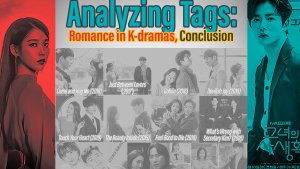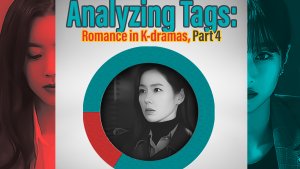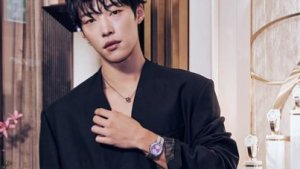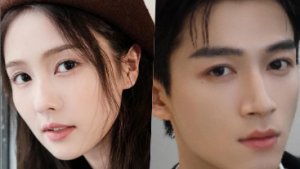 A Tag Analysis: Romance in K-Dramas - Conclusion
A Tag Analysis: Romance in K-Dramas - Conclusion

Though I've only been watching K-dramas since 2017, I've picked up some of the visual cues used to establish a character's or characters' mental state. These are so prevalent, they've become an intricate part of Korean visual communication in my eyes.
Initially, I wanted to list all the cues and cover them briefly in this article. However, it became evident that there was a lot to cover with each technique and its variations if I wanted to do them justice. So I had to change my approach.
In an effort to keep this article at a manageable and/or digestible length, I'm going to cover the subject over the course of two articles. Part one will cover two of the most prevalent cues used to establish interpersonal relationships between one or more characters. While part two will cover some of the cues used to establish a character's state of mind or his/her "process of introspection".
Update (2/5/2019) | After the feedback I received in this article, coupled with the structure of the new article, I decided to split part two into two parts in order to keep the length "bite-size" and avoid overwhelming you with information. This is the new structure I've come up with and which I'll try to adhere to. Think about it as an index for this series of articles:
INDEX | |
|---|---|
| PART ONE (current article) | Covered two of the most common cues used to establish interpersonal relationships. |
PARTS TWO TO FOUR will cover two of the most common interpersonal cues. Meaning, cues used to establish a character's state of mind or his/her "process of introspection". The fourth article will cover several examples where more than one cue is being used in a scene or shot. | |
| PART TWO (read here) | Interpersonal Cues: Boxing |
| PART THREE (read here) | Interpersonal Cues: The Dutch Angle |
| PART FOUR | Interpersonal Cues: Overview |
POPULAR MOTIFS IN K-DRAMASThis will be a different series of articles but on a similar vein. These set will cover prevalent motifs used in k-dramas to build an additional narrative within the story. I'll be covering one motif and it's variations per article. Once I start working on them, the structure may change. | |
| PART ONE | Popular Motifs in K-Dramas: Mirrors, Windows & Reflections |
| PART TWO | Popular Motifs in K-Dramas: Rain, Water & Submerging |
| PART THREE | Popular Motifs in K-Dramas: Feet, Shoes & Direction |
It's important to understand that these cues stand out because they add more than just composition to a shot.
They add a subtext which most times reinforces the narrative... but which may also, at times, contradict the script.
In a way, they allow the director to communicate directly with us. So that even when the writers may be doing their best to confuse us, a good director will leave hints of the truth through carefully placed shots.
Keep in mind that this is also my personal interpretation of the cues. As such, your take on some of the examples may differ from mine. If so, please let me know in the comments down below. I'd love to hear your thoughts and discuss things I might've missed!
With that said, let's take a look at some examples of interpersonal relationships in K-dramas established through framing.

The first set of cues show visual ways to establish a
CONFLICT, DIVISION, OR FIGHT
between two or more characters.
I like this one because through simple framing we get a lot of subtext to a scene. The beauty resides in using a single shot --which can last mere seconds-- to establish a sense of "where the characters stand".

Notice the inclusion of an object or line in the shots above. The object or line cuts through the frame, effectively separating the characters. Through careful composition, the director has shown us that the characters are divided.
Another way to look at it is that one or both characters are guarded. Either they do not trust the other person yet or they've lost trust. This is often the case when it comes to stories where the characters start off "on the wrong foot", as is the premise of many rom-coms. So look for these types of techniques when watching these shows.
The Ghost Detective | Come and Hug Me |
The characters have a tensed reunion after an event put a strain in Da Il's (the ML's) and Yeo Wool's (the FL's) relationship. This shot doesn't just show that they are unsure of where they stand, but that they are in opposition. The director uses the shadows to literally draw a line on the ground, which the characters are unable or unwilling to cross.It's worth noting that there's an additional subtext that deals with the classic theme of "corruption vs purity". [If you're interested to know more, I covered this scene in more detail in my article 5 Reasons To Watch "The Ghost Detective" (2018) .] | Our main leads meet after a very traumatic experience. Nah Moo (the ML) is hunched down, alone in the snow, feeling responsible for the tragedy that befell Nak Won (the FL). Meanwhile, Nak Won had been riding in a police car when she spots Nah Moo. She gets out of the car and hurries to him, only to stop on her tracks once she's closer. A dead tree looms over them, acting as a wide, solid and almost impenetrable barrier.This pause creates tension because we don't know if their fragile love has survived the onslaught of pain. |


Bad Papa |
The third example comes from Bad Papa. I've included a gif because I adore this shot and the tension it builds. Despite its many flaws, there were a number of beautiful shots coupled with a superb music choice that made up for some of the writing's mess. This moment ranks among its best. In this scene, Ji Cheol (the ML) is meeting another MMA fighter. The scene is supercharged with tension because the fighter called him not long before, threatening to go public with something that would affect Ji Cheol. The shot on the left is powerful because we not only see them standing right across one another, with a literal yellow line dividing them. But we also see Ji Cheol's side tainted red; a color often used to portray "danger" or someone "evil".And if you've seen the drama, you know both interpretations would fit him like a glove. |

In these shots, the division is established through a more clear-cut, albeit subtle line. This is the more common use of the technique. Yet, if you're not looking for it, you might still miss the object that's cutting through the frame.
The Beauty Inside | Fight for my Way |
In this shot, we see our main leads sitting side by side. At this point, they'd already established a reluctant alliance. Though their relationship had been amicable, a misunderstanding not long before this scene caused a visible shift. Even if the characters are acting like nothing's wrong, the director creates a visual rift by separating them with the umbrella.And this awkward barrier remains throughout the entire scene. | In the shot, Seol Hee and Joo Man (2FL and 2ML respectively) meet after a difficult event. The director reinforces the conflict by separating them with the light pole in the background.In fact, the shot does a great job of creating tension by having Joo Man (the guilty party) walk out of his apartment and stop before crossing that invisible line --similar to the Come and Hug Me example we covered before. |

Another way to demonstrate conflict is by boxing a character. Not only does this create division, but it also establishes that the characters may be feeling guarded or trapped.
Mother | Priest |
In this shot, we see two characters having a difficult conversation. Both regard each other carefully, fully aware that though they care for the same person, they don't really care for each other. The camera peeps at them from outside the shop and uses the division in the window's pane to box them. | In the shot, the director takes things up a notch. The camera looks at the characters from behind four panes of glass. Though there are only two characters in the shot, we see three boxes.That's because the man (middle) has been separated not only from Dr. Ham (the FL, standing on the right) but also from the wall where a candid picture of her is being projected (left). There's also a fourth box on the very right, but the reason behind it is up to interpretation since it shows a hint of the man's bed. So whether you see it as a further separation of Dr. Ham and the man is up to you. |

Now that we've covered the common ways this cue is used, I'd like to show examples of a more creative and poetic way of using the technique.
Both of these scenes show a separation between a character and an object, rather than a person.
And that's because that object represents another character.
Naturally, for this to work, the connection between the character and the object has to have been established clearly before this shot. Otherwise, it will make no sense --especially given they usually last a few seconds.
Mother | The Third Charm |
In this shot, Yoon Bok (the FL) is sitting on the ground, hunched down, with her back pressed against the door. She'd just overheard a discussion involving her current predicament. Not wanting to cause problems, Yoon Bok contemplates her options in silence. Nearby, we see the precious dolls her mother gave her, which she'd set in a row by the windowsill. The director frames the shot to hint at a separation (which can be emotional, mental or physical) between Yoon Bok and her 38-year-old mom, who is represented by the second to last Russian doll. | Warning: a spoiler for The Third Charm below. Read the details marked as spoilers at your own risk. Yeong Jae (the FL) is walking down the streets at night when she remembers a conversation she had with her daughter. Sitting on her lap, her daughter told Yeon Jae that she wanted to eat a lot so she could be chubby like the moon. When Yeon Jae asked why she loves the moon so much, her daughter responded that "the moon could be seen from everywhere and it always stays the same." When Yeon Jae snaps back to reality she falls to her knees and looks up at the moon. Not only is there a separation by distance, but we also get a light pole cutting through the frame, reminding us that no matter how much she wishes for it, Yeon Jae can never be with her daughter again. |
Now that we've covered the cues dealing with conflict and division, let's explore some of the ones dealing with the opposite.

The second set of cues show ways to establish
TRUST, UNDERSTANDING, OR AN ALLIANCE
between two or more characters.
Like with the first set, we get a lot of subtext to a scene through simple framing, which helps us better understand what the characters are feeling towards one another.

Mother | Where Stars Land |
In this shot, we see Jin Hong (the ML) sitting together with Soo Jin (the FL). This shot doesn't just have beautiful symmetry, but we also get the sense that they are a unit, as the camera peeps at them through an ornate pane of glass. | In this scene, Dae Ki (the 2ML) walks into the supermarket where Yeong Joo (the 2FL) is having dinner and asks if he can join her. When she gives him the go-ahead, he chooses the seat to her left, so when the camera frames them through the window, they are boxed in together. |

These examples show another prevalent use of the technique, which is when a shot groups two or more characters, while simultaneously separating them from others.
Hello, Monster | Feel Good to Die |
In this shot, we get the first meeting between Lee Hyun (the ML) and the group of detectives working the scene of a crime. The camera boxes the detectives through a shelf, and at the same times sets Lee Hyun apart.The shot establishes that Lee Hyun isn't part of the team. What's more, the fact that he's "outside the box" also implies that he holds an edge over the group. | With this shot, the director uses a glass pane to separate Kang Jun Ho (2ML) from Lee Roo Da & Baek Jin Sang (our protagonists). This division is reinforced by the conversation and the context of the show. Wherein Kang Jun Ho remarks that they seem to be a keeping a "secret" from him. The fact that he's boxed in tight further establishes the feeling of being "left out", "kept in the dark" or having "less knowledge".If we study the composition, it's also clear that the group has the power --as their side is eating up more than half of the frame. [I'll cover the visual establishment of power in the next section.] |

Come and Hug Me |
This shot groups two characters which stand at odds with one another while at the same time, separating them from the rest of the class.This scene is visually heavy with connotations since the script has been showing us how different the two characters are. One a bully (ML's older brother), the other the student that confronts him (FL's older brother). Yet, the director tells us that they are more alike than we'd think by boxing them together. |

Hello Monster |
This shot groups two characters through boxing while at the same time, separating them from an object which represents another character.This shot could be interpreted a number of ways, however. Because if you've seen this show, then you know that painting has a lot of connotations. I'll share two connotations below, but I'll mark them as a spoiler since they both give away a key plot point. Given I'm re-watching this show with a friend, I realized that this shot has a separation not just between three characters, but between two relationships. On the left side, we have the relationship between two brothers and their complex form of love. On the other, you have the relationship between our main leads, which shows a simpler kind of love. Another interpretation is a separation between cases. If you've watched the series, you also know that those flowers represent another antagonist. So you could also see this one also as a separation between two antagonists; with the leads being grouped inside the box of the case they are currently working (which involves the blue hyacinth). While the other box eludes them still but shadows them for the entire series. Although I'll admit, this one is much more far-fetched. |
So now that we've explored these cues, let's look at examples where they've been integrated in a fluid way, emphasizing a visual shift in the relationship between one or more characters as a scene plays out.

The following scenes demonstrate the shift in the
CHARACTER'S EMOTIONAL OR MENTAL STATE
through the use of dividing and grouping cues.

Some shifts are very subtle and you'll only catch them if you pay attention to what's happening in the background. Let's deconstruct the shots above to better identify the important lines and how they shift.

Because This is My First Life |
In this scene Se Hee (the ML) and Jo Ho (the FL) are meeting after finding out the roommate they've been living with, was not who they imagined. For those who haven't seen the drama, Se Hee is the owner of the house, while Jo Ho is his tenant. So in the first shot, we see Se Hee asking Jo Ho if they can have a conversation. Se Hee looks uncomfortable because she's in a difficult position. She has much more to lose than Se Hee. After all, she isn't just jobless but homeless as well! Her feeling of being "trapped" is portrayed by how the director uses the people in the foreground to box her in, leaving her with little room to breath in comparison to Se Hee. As they move to sit at a bench (second shot), the director makes sure to keep Jo Ho trapped by using the trees in the background to once again box her in tight. Her discomfort is further reinforced by her body language. However, as the conversation progresses (third shot), the director releases Jo Ho from her prison. Notice how the new angle shifts the trees away from her and her body language is also more relaxed. To show they are now "on the same page", the director switches the angle by the end of the scene to frame them using the trees --grouping them into a solid unit.Notice how their body language matches their new state, one of relaxation, comfort, and harmony. |

Because This is My First Life |
In this scene, our protagonists drift apart after a difficult conversation. In the first shot, Se Hee (the ML) tells Jo Ho (the FL) that he's uncomfortable with some of the things she had done --effectively reminding her that their contract marriage is one of convenience. That tension and division is maintained throughout the scene that unfolds the following morning. As the conversation progresses, the scene ends with See Hee moving to sit on the couch, visually accentuating that the rift between them has become wider. In fact, take a look at the "lines of separation drawn" and how they increase as the scene progresses.You get one line in the first two shots, then three lines and finally the scene ends with more than four lines of separation. |
Another thing to keep a lookout for is a shift in power within a shot or scene achieved through a visual hierarchy. |
 This scene offers a great example of a shift in power, which is established by how much "space" the character is given within the frame. In the first shot, See Hee has more power. Not only is she living in his house, but he's also enforcing the rules of their engagement. Jo Ho, on the other hand, is boxed in tight, establishing that she's feeling trapped and her guard is coming up. In the following scene, we see Jo Ho fight See Hee for dominance. And though he still holds more power, she demonstrates that she won't be pushed and pulled around so easily. |
In contrast, look at the shots below. Notice how they display a balance of power since both "boxes" or "sides" are of equal size. This tells us that both characters are feeling guarded or tensed in the same proportion.
|

The Beauty Inside |
In this scene, we get a separation enforced by a last "poetic" shot. In the first shot, our protagonists, Do Jae (the ML) and Se Kye (the FL) rest together in complete comfort. The box gives a sense that they are enjoying a cozy night. Notice that the other box doesn't show the complete vase here. As the scene progresses, Se Kye learns something that makes her uncomfortable. And although she tries to act naturally as she gets up to leave (second shot), the director boxes them separately, telling us they are divided. The last shot reinforces the separation by not only boxing Do Jae, but by shifting the angle so the other box holds the vase that represents Se Kye. (This link was established early on when Do Jae asked his secretary to describe Se Kye, and he used a specific type of porcelain to describe her skin. That vase in his house just so happens to be made of the aforementioned porcelain.) |


Perhaps the most common way to shift a relationship is by having one character "cross" into the other person's side, joining them.
Come and Hug Me | Mother |
In this scene, Soh Jin (ML's adoptive sister) crosses into Hyun Moo's (ML's older brother) side, reminding him she's not his enemy. | In this shot, Dr. Hong Jong (the ML) breaks into Kang Soo Jin and Yoon Bok's (the FLs) box by reaching out to them, establishing a sense that "he's on their side". |

Gu Family Book |
This is another example of a character "crossing over" to the other side in order to transition from division into becoming a group or unit. I've added this example as an afterthought because it's the more common form of execution. Where you'll have the same angle showing the transition. |


Fight for My Way |
One of the things I love about Fight for My Way, is how straightforward the characters are. That honesty is reinforced by the director on several occasions throughout the drama, always with great success. I think this scene speaks for itself, but in case you haven't watched the show, here we see Dong Man (the ML) acting on his growing feeling towards Ae Ra (the FL) by moving her out of the Park Moo Bin's (minor 2ML) box and into his. |

Come and Hug Me |
This example shows a shift built throughout the series rather than during only one scene, which shows an outstanding level of "attention to detail." In the first shot, we have the tree separating Nak Won (the FL, who survived an attack), from the pictures of her parents (who were murdered during that attack). Later on, we have Nah Moo (the ML) also separated from the portrait of his father’s victims. Except that since Nah Moo is represented by the tree within the show, we get an additional line to keep both him and the tree on the other side. As the drama unfolds, we eventually get to the last shot, where both Nah Moo and Nak Won stand with her parents. It’s a beautiful shot that suggests they have found peace together in Nak Won’s world. [For those interested, I've covered this and more in my article The Visual Mastery of Come and Hug Me.] |
Did you enjoy the article?
I'd love to hear your thoughts in the comments down below. Here are some questions to get a conversation started:
- Do you agree with my take on the examples? If so, why or why not?
- Have you noticed these cues before?
- Are there other cues related to interpersonal relationships that you've picked up in K-dramas and which I might've missed?
- Did you like the length of the article? Would you rather see more examples in the next article, less or the same?
- Where my explanations clear?
- Would you like to read more articles like this? Why or why not?












